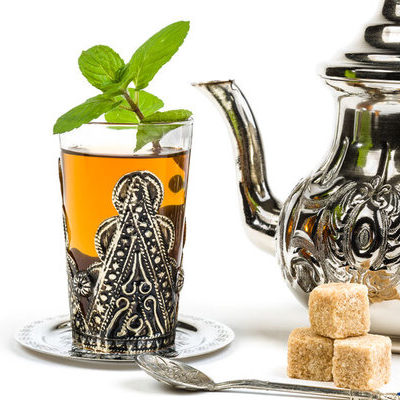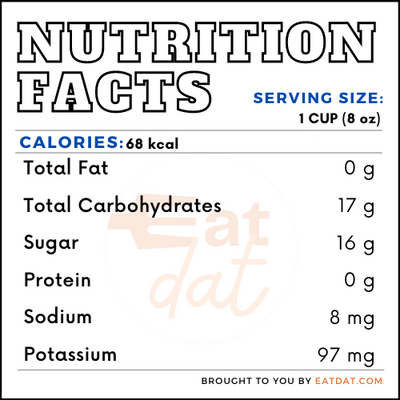
Maghrebi Mint Tea
Also known as Moroccan Mint Tea, Atay Bi Na’na
What is Maghrebi Mint Tea?
Maghrebi mint tea is a sweet tea drink that is consumed hot. It is made of spearmint, sugar, green tea, and hot water.
- Sometimes, herbs such as wormwood, lemon verbena, star anise, and saffron may also be added.
- It is the national beverage of Morocco and most closely identified with the country, but is also popular in Algeria, Tunisia, Libya, Mauritania, France, and Spain.
The tea is central to social life in the North African countries and may be practiced in a ceremonial manner when guests are honored. Men often make this drink and offer it to guests as a gesture of hospitality.
The most popular mint tea brands available on the market are:
- Buddha Teas
- Numi
- Stash Tea
- The Tao of Tea
- Tea Forte
- Rishi Mystic
- Bigelow
- The Republic of Tea
- Tiesta Tea
Origin of maghrebi mint tea
The origin of this mint tea has conflicting accounts. Some theories claim that green tea came to Morocco by way of Arab trade with the East. Others claim that Queen Anne of England gave green tea to Morocco as a gift. However, the most accepted version is that a British merchant, unable to sell gunpowder tea from China in Scandinavia due to the Crimean War, decided to stop en route and sell it in Morocco, where he was met with unexpected success. The locals boiled the gunpowder tea with readily available spearmint and imported sugar, giving rise to the Maghrebi mint tea.
Nutrition
One cup of this tea contains:

Evidence suggests that incidence of certain types of cancer is lower among green tea drinkers due to its high level of antioxidants and available polyphenols. Drinking green tea is also linked to lower cholesterol, lower risk of strokes and type 2 diabetes, as well as promoting weight loss. Studies also suggest that regular consumption of green tea might help in reducing the risk of Alzheimer’s disease. Green tea also contains caffeine, which helps stimulate the brain.
Spearmint is rich in polyphenols, such as rosmarinic acid, which has a positive effect on cognitive performance, sleep, and is a mood enhancer and relaxant. It also may reduce age-related memory impairment. Nonetheless, due to the large amount of sugar contained in Maghrebi mint tea, it is advisable to consume it in moderation. Sugar can be good for the health of the brain, provided it is taken in balanced quantities. However, overconsumption of sugar can lead to an increase in the risk of heart diseases, diabetes, cancer, and other diseases. It can also lead to obesity, depression, and aging.
Commercial production
Mint tea is found everywhere in North Africa and the Maghreb. It may be ordered in all cafés and restaurants in this region. It is usual to serve mint tea in at least three helpings, in keeping with the ancient Moroccan proverb: The first glass is as bitter as life, the second glass is as strong as love, the third glass is as gentle as death.
The preparation is simple and merely requires gunpowder green tea, fresh spearmint, and sugar. First, the water is boiled and put into the teapot along with the gunpowder leaves, which is then strained away to clean the tea leaves. Then, more boiling water, sugar, and mint are added to the teapot, which is then placed for half a minute over medium heat. After that, the drink is allowed to steep before serving.
Maghrebi mint tea recipes
This mint tea is a staple in many cultures. It is mainly a hot beverage to be drunk throughout the year. Although in some cases, it may also be used to flavor meat and other dishes. Here are some popular recipes:
- Moroccan Mint Tea
- Moroccan Lamb Stew with Mint Tea and Apricots
- Mint Tea Couscous
- Moroccan Mint Green Tea Lamb Loin
FDA regulations
The FDA has standards and specifications for tea bags or infusers, which must be adhered to. The USDA covers other aspects of green tea production, import, and packaging. The USDA also governs green tea mixes, specifying that they must be of light to medium amber color, have uniform distribution of ingredients, and no anti-caking agents. However, all tea processing must be done in accordance with the sanitary and safety requirements of the FDA.
References
What are the health benefits of green tea?, Medical News Today https://www.medicalnewstoday.com/articles/269538
“Tea” Encyclopedia of Products & Industries – Manufacturing. Encyclopedia.com. 23 May. 2020
https://www.encyclopedia.com/plants-and-animals/plants/plants/tea
Ahmed, Selena & Stepp, John. (2012). Green Tea: The Plants, Processing, Manufacturing and Production. 10.1016/B978-0-12-384937-3.00002-1.
https://www.researchgate.net/publication/268391107_Green_Tea_The_Plants_Processing_Manufacturing_and_Production
Fujiki, Hirota et al. “Cancer Prevention with Green Tea and Its Principal Constituent, EGCG: from Early Investigations to Current Focus on Human Cancer Stem Cells.” Molecules and cells vol. 41,2 (2018): 73-82. doi:10.14348/molcells.2018.2227
https://www.ncbi.nlm.nih.gov/pmc/articles/PMC5824026
Herrlinger, Kelli A et al. “Spearmint Extract Improves Working Memory in Men and Women with Age-Associated Memory Impairment.” Journal of alternative and complementary medicine (New York, N.Y.) vol. 24,1 (2018): 37-47. doi:10.1089/acm.2016.0379
https://www.ncbi.nlm.nih.gov/pmc/articles/PMC5779242/
